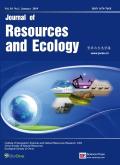Assessing Vulnerability to Environmental Changes of Freshwater Crab, Thaipotamon chulabhorn in the Dun Lumpun Non-Hunting Area, Thailand
Q3 Environmental Science
引用次数: 0
Abstract
Abstract: Thaipotamon chulabhorn (Mealy Crab) is a freshwater crab, listed as ‘Least Concerned’ in the IUCN Red List of Threatened Species. Nonetheless, this crab is exclusively found in one small area of the Dun Lumpun Forest, Thailand, and currently faces high exposure to environmental changes. This study aims to investigate key dynamic factors that influence vulnerability to environmental changes of the Mealy Crab. The study was conducted between 15 March and 23 October 2016, covering the local summer until the end of the rainy season and being influenced by strong El Niño, thus suggesting drought episodes. This vulnerability assessment was carried out through crab population records from 1997 to 2016, field measurements/surveys, and interviews with experienced park rangers. The results revealed that drought is the major vulnerability factor that is threatening the population of the crabs and their livelihoods (7.96 out of 10), followed by an increased number of their natural enemies (7.41), variations in groundwater level (6.11), changes in groundwater quality (4.63), changes in forest soil (4.63) and human intervention (4.26). Since 1996, human intervention has been found to have a little direct impact on the crab population due to the restricted access to forest resources. The 2016 drought was accompanied by anomalously low rainfall and the early onset of the rainy season, contributing to an earlier and shorter mating period of the crabs. Nonetheless, a consistently increased number of the Mealy Crab population indicated that they are not significantly vulnerable to a larger number of their natural enemies, and even to the changes in groundwater and forest soil. In conclusion, the crab population was increasing along with changes in the habitat and climate and its growth cycle was unusual during the drought.泰国敦伦本非狩猎区淡水蟹Thaipotamon chulabhorn对环境变化的脆弱性评估
摘要:泰国绒蟹(Thaipotamon chulabhorn)是世界自然保护联盟濒危物种红色名录中“最不受关注”的淡水蟹。尽管如此,这种螃蟹只在泰国Dun Lumpun森林的一个小区域被发现,目前面临着高度暴露于环境变化的风险。本研究旨在探讨影响粉蟹对环境变化脆弱性的关键动态因素。该研究于2016年3月15日至10月23日期间进行,涵盖了当地夏季至雨季结束,并受到强厄尔尼诺Niño的影响,因此表明发生了干旱事件。脆弱性评估是通过1997年至2016年的螃蟹种群记录、实地测量/调查以及对经验丰富的公园护林员的采访进行的。结果表明,干旱是影响大闸蟹种群及其生计的主要脆弱因素(7.96),其次是天敌数量增加(7.41)、地下水位变化(6.11)、地下水水质变化(4.63)、森林土壤变化(4.63)和人为干预(4.26)。自1996年以来,由于森林资源的限制,人类干预对螃蟹种群的直接影响很小。2016年的干旱伴随着异常低的降雨量和雨季的提前到来,导致大闸蟹的交配期提前和缩短。然而,粉蟹种群数量的持续增加表明,它们对天敌数量的增加并不明显脆弱,甚至对地下水和森林土壤的变化也不脆弱。综上所述,干旱期蟹的数量随生境和气候的变化而增加,生长周期不正常。
本文章由计算机程序翻译,如有差异,请以英文原文为准。
求助全文
约1分钟内获得全文
求助全文
来源期刊

Journal of Resources and Ecology
Environmental Science-Ecology
CiteScore
2.40
自引率
0.00%
发文量
107
 求助内容:
求助内容: 应助结果提醒方式:
应助结果提醒方式:


